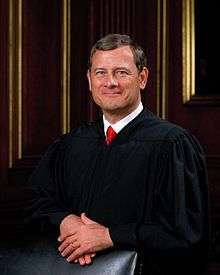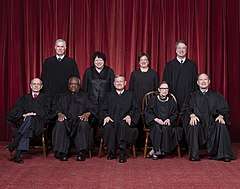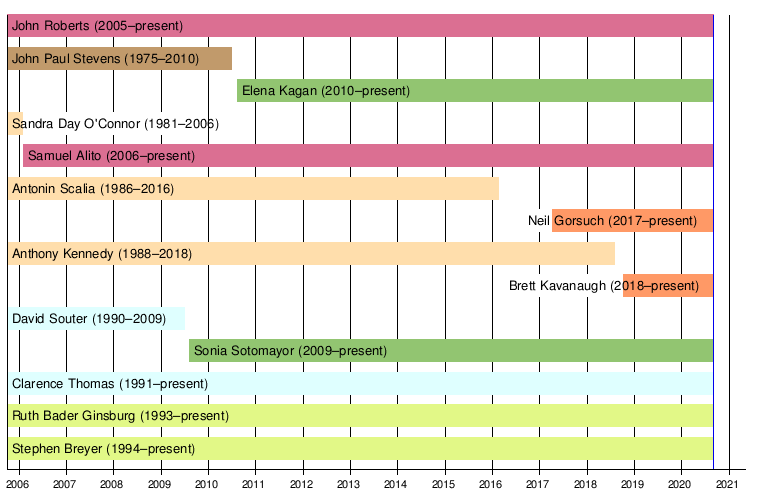Roberts Court
The Roberts Court is the time since 2005 during which the Supreme Court of the United States has been led by Chief Justice John Roberts. It is generally considered more conservative than the preceding Rehnquist Court, as a result of the retirement of moderate Justice Sandra Day O'Connor and the subsequent confirmation of the more conservative Justice Samuel Alito in her place.[1]
| Roberts Court | |
|---|---|
|
→ Current | |
 | |
| Since September 29, 2005 – 14 years, 321 days | |
| Seat | Supreme Court Building Washington, D.C. |
| No. of positions | 9 |
| Roberts Court decisions | |
 | |
Membership
Roberts was originally nominated by President George W. Bush to replace Associate Justice Sandra Day O'Connor, who had decided to retire from the Court, effective with the confirmation of her successor. However, before the Senate could act upon Roberts' nomination to be an Associate Justice, Chief Justice William Rehnquist died, and President Bush nominated Roberts for the Chief Justice vacancy. Roberts' nomination as Chief Justice was confirmed by the Senate in 2005. Roberts took the Constitutional oath of office, administered by senior Associate Justice John Paul Stevens (who was the acting Chief Justice during the vacancy) at the White House, on September 29, 2005, almost immediately after his confirmation. On October 3, Roberts took the judicial oath provided for by the Judiciary Act of 1789, prior to the first oral arguments of the 2005 term. The Roberts Court commenced with Roberts as Chief Justice and eight holdovers from the Rehnquist Court: Stevens, O'Connor, Antonin Scalia, Anthony Kennedy, David Souter, Clarence Thomas, Ruth Bader Ginsburg, and Stephen Breyer.
President Bush nominated Samuel Alito (after the withdrawal of Bush's first nominee, White House Counsel Harriet Miers) to replace O'Connor, and he was confirmed in January 2006. In 2009, President Barack Obama nominated Sonia Sotomayor to replace Souter, and in 2010 Obama nominated Elena Kagan to replace Stevens. After six years, Justice Scalia died in February 2016. In the following month Obama nominated Merrick Garland, but Garland's nomination was never considered by the Senate, and it expired when the Senate's 114th Congress ended and the 115th Congress began on January 3, 2017. Eleven days after the 2017 Inauguration, on January 31, 2017, President Donald Trump nominated Neil Gorsuch to replace Scalia. Democrats in the Senate filibustered the Gorsuch nomination, which led to the Republicans exercising the "nuclear option". After that, Gorsuch was confirmed in April 2017. On July 9, 2018, Trump nominated Brett Kavanaugh to replace Kennedy (who retired on July 31)[2], and he was confirmed on October 6, 2018.
Timeline
Rulings of the Court

Front row (left to right): Stephen Breyer, Clarence Thomas, John Roberts (Chief Justice), Ruth Bader Ginsburg, and Samuel A. Alito. Back row (left to right): Neil Gorsuch, Sonia Sotomayor, Elena Kagan, and Brett Kavanaugh
The Roberts court has issued major rulings on gun control, affirmative action, campaign finance regulation, abortion, capital punishment, gay rights, unlawful search and seizure, and criminal sentencing. Major decisions of the Roberts Court include:[3][4]
- Massachusetts v. EPA (2007): In a 5–4 decision in which the majority opinion was delivered by Justice Stevens, the Supreme Court upheld the Environmental Protection Agency's right to regulate carbon dioxide under the Clean Air Act.
- District of Columbia v. Heller (2008): In a 5–4 decision in which the majority opinion was delivered by Justice Scalia, the Supreme Court held that the Second Amendment applies to federal enclaves, and that the amendment protects the right of individuals to possess a firearm, regardless of service in a militia. McDonald v. City of Chicago (2010), in a 5–4 decision written by Justice Alito, extended this protection to the states.
- Ashcroft v. Iqbal (2009): In a 5–4 decision written by Justice Kennedy, the court reversed the Second Circuit's decision not to dismiss a suit against former Attorney General John Ashcroft and others that claimed that the FBI engaged in discriminatory activities following the 9/11 attacks. The court also extended the heightened pleading standard established in Bell Atlantic Corp. v. Twombly (2006), which had previously applied only to antitrust law. The number of dismissals greatly increased after the Iqbal ruling.[5]
- Citizens United v. Federal Election Commission (2010): In a 5–4 decision in which the majority opinion was delivered by Justice Kennedy, the Court held that the provisions of the Bipartisan Campaign Reform Act which regulated independent expenditures in political campaigns by corporations, unions, and non-profits violated First Amendment freedom of speech rights.
- National Federation of Independent Business v. Sebelius (2012): In a 5–4 decision written by Chief Justice Roberts, the Court upheld most of the provisions of the Patient Protection and Affordable Care Act, including the individual mandate to buy health insurance. The mandate was upheld as part of Congress's power of taxation. In a subsequent case, King v. Burwell (2015), the Court upheld the Patient Protection and Affordable Care Act, this time in a 6–3 opinion written by Chief Justice Roberts.
- Arizona v. United States (2012): In a 5–3 decision delivered by Justice Kennedy, the Court held that portions of Arizona SB 1070, an Arizona law regarding immigration, unconstitutionally usurped the federal authority to regulate immigration laws and enforcement.
- Shelby County v. Holder (2013): In a 5–4 decision delivered by Chief Justice Roberts, the Court struck down Section 4(b) of the Voting Rights Act of 1965, which provided a coverage formula for Section 5 of the Voting Rights Act. The latter section requires certain states and jurisdictions to obtain federal preclearance before changing voting laws or practices, in an effort to prevent those states and jurisdictions from discriminating against voters. Without a coverage formula, Section 5 of the Voting Rights Act is no longer in effect.
- Burwell v. Hobby Lobby (2014): In a 5–4 decision delivered by Justice Alito, the Court exempted closely held corporations from the Affordable Care Act's contraception mandate on the basis of the Religious Freedom Restoration Act.
- Riley v. California (2014): The Court unanimously held that the warrantless search and seizure of digital contents of a cell phone during an arrest is unconstitutional.
- Obergefell v. Hodges (2015): In a 5–4 decision delivered by Justice Kennedy, the Court held that the Due Process Clause and the Equal Protection Clause both guarantee the right of same-sex couples to marry.
- Whole Woman's Health v. Hellerstedt (2016): In a 5–3 decision delivered by Justice Breyer, the Court struck down restrictions the state of Texas had placed on abortion clinics as an "undue burden" on access to abortion.
- Trump v. Hawaii (2017): In a 5–4 decision written by Chief Justice Roberts, the Court overturned a preliminary injunction against the Trump Travel Ban, allowing it to go into effect. The Court also overturned the precedent Korematsu v United States (1944), which allowed President Franklin Delano Roosevelt to intern Japanese-Americans during World War II.[6]
- Carpenter v. United States (2018): In a 5–4 decision written by Chief Justice Roberts, the Court held that government acquisition of cell-site records is a Fourth Amendment search, and, thus, generally requires a warrant.
- Timbs v. Indiana (2019): In a unanimous decision, the Court ruled that the "excessive fines" clause of the Eighth Amendment is incorporated against state and local governments, affecting the use of civil forfeitures.
- Rucho v. Common Cause (2019): In a 5–4 decision written by Chief Justice Roberts, the Court held that partisan gerrymandering claims present nonjusticiable political questions.
- Bostock v. Clayton County, Georgia (2020): In a 6–3 decision, the Court ruled that Title VII employment protections of the Civil Rights Act of 1964 do extend to cover gender identity and sexual orientation.
Judicial philosophy
The Roberts Court has been described as "conservative in most cases, liberal in some," with (prior to the death of Justice Scalia) five conservative-leaning justices and four liberal-leaning justices. Alito, Thomas, Kennedy, Roberts, and Scalia generally have taken more conservative positions, while Ginsburg, Breyer, Sotomayor, and Kagan have generally taken more liberal positions. Souter and Stevens had also been part of the liberal bloc prior to their respective retirements. These two blocs of voters have lined up together in several major cases, though Justice Kennedy has often sided with the liberal bloc. Roberts has also served as a swing vote, often advocating for narrow rulings and compromise among the two blocs of Justices.[4][7] Though the Court often does divide along ideological lines, attorney and SCOTUSblog founder Tom Goldstein has noted that many cases are decided 9–0 and that the individual judges hold a wide array of views.[8]
The judicial philosophy of Roberts on the Supreme Court has been assessed by leading court commentators including Jeffrey Rosen[9] and Marcia Coyle.[10] Although Roberts is identified as having a conservative judicial philosophy, his vote in National Federation of Independent Business v. Sebelius (2012) upholding the constitutionality of the Patient Protection and Affordable Care Act (ACA) has caused reflection in the press concerning the comparative standing of his conservative judicial philosophy compared to other sitting justices of conservative orientation; he is seen as having a more moderate conservative orientation, particularly when his vote to uphold the ACA is compared to Rehnquist's vote in Bush v. Gore.[11]
Regarding Roberts' contemporaneous peers on the bench, his judicial philosophy is seen as more moderate and conciliatory than that of Antonin Scalia and Clarence Thomas.[9][11] Unlike Scalia, Roberts has not indicated any particularly enhanced reading of originalism or framer's intentions as has been plainly evident in Scalia's speeches and writings.[10] Roberts' strongest inclination on the Court has been to attempt to re-establish the centrist orientation of the Court as being party neutral, in contrast to his predecessor Rehnquist who had devoted significant effort to promote a states rights orientation for the Court. Roberts' voting pattern reflecting his conservative judicial philosophy is most closely aligned to Samuel Alito on the Court,[12] the latter of whom has also become associated with libertarian trends in the conservative judicial philosophy.[9]
List of Roberts Court opinions
- Supreme Court opinions during the 2005 term
- Supreme Court opinions during the 2006 term
- Supreme Court opinions during the 2007 term
- Supreme Court opinions during the 2008 term
- Supreme Court opinions during the 2009 term
- Supreme Court opinions during the 2010 term
- Supreme Court opinions during the 2011 term
- Supreme Court opinions during the 2012 term
- Supreme Court opinions during the 2013 term
- Supreme Court opinions during the 2014 term
- Supreme Court opinions during the 2015 term
- Supreme Court opinions during the 2016 term
- Supreme Court opinions during the 2017 term
- Supreme Court opinions during the 2018 term
- Supreme Court opinions during the 2019 term
References
- Liptak, Adam (2010-07-24). "Court Under Roberts Is Most Conservative in Decades". New York Times. New York, New York. Retrieved 2010-08-05.
- "Trump gets chance to reshape top court". BBC News. 2018-06-27. Retrieved 2018-06-27.
- Chiusano, Scott (September 29, 2015). "Landmark decisions during John Roberts' decade as Chief Justice". New York Daily News. Retrieved February 25, 2016.
- Wolf, Richard (September 29, 2015). "Chief Justice John Roberts' Supreme Court at 10, defying labels". USA Today. Retrieved February 25, 2016.
- Liptak, Adam (May 18, 2015). "Supreme Court Ruling Altered Civil Suits, to Detriment of Individuals". New York Times. Retrieved March 3, 2016.
- "One Really Good Thing in the Supreme Court's Travel-Ban Ruling: Korematsu Is Gone".
- Fairfield, Hannah (June 26, 2014). "A More Nuanced Breakdown of the Supreme Court". New York Times. Retrieved February 25, 2016.
- Goldstein, Tom (June 30, 2010). "Everything you read about the Supreme Court is wrong (except here, maybe)". SCOTUSblog. Retrieved July 7, 2010.
- Rosen, Jeffrey (July 13, 2012). "Big Chief".
- Marcia Coyle, The Roberts Court: The Struggle for the Constitution, 2013.
- Scalia, Antonin; Garner, Bryan A. (2008) Making Your Case: The Art of Persuading Judges (St. Paul: Thomson West) ISBN 978-0-314-18471-9.
- "Which Supreme Court Justices Vote Together Most and Least Often". The New York Times. June 24, 2014.
Further reading
- Chemerinsky, Erwin. "Roberts Court at Age Three, The." Wayne L. Rev. 54 (2008): 947.
- Collins, Ronald KL. "Foreword, Exceptional Freedom—The Roberts Court, the First Amendment, and the New Absolutism." Albany Law Review 76.1 (2013): 409-66. online
- Franklin, David L. "What kind of business-friendly court? Explaining the Chamber of Commerce's success at the Roberts Court." Santa Clara Law Review 49 (2009). online
- Gottlieb, Stephen E. Unfit for Democracy: The Roberts Court and the Breakdown of American Politics (New York University Press, 2016. xii, 381 pp
- Liptak, Adam. "Court under Roberts is most conservative in decades." Sup. Ct. Preview (2012): 48. online
- Mazie, Steven V. American Justice 2015: The Dramatic Tenth Term of the Roberts Court. (University of Pennsylvania Press, 2015).
- Tushnet, Mark. In the Balance: Law and Politics on the Roberts Court (WW Norton, 2013). Pp. xviii, 324pp
